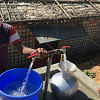UNHCR concerned over ‘rain risk’ of Rohingyas

UNHCR, the UN Refugee Agency, and its partners are ramping up efforts to mitigate some of the expected impacts of the upcoming monsoon season in Bangladesh.
Adverse weather conditions could put tens of thousands of Rohingya refugees staying at the highly congested settlements in Cox's Bazar district at serious risk, said UNHCR spokesperson Andrej Mahecic during a press briefing in Geneva today.
Bangladesh has acknowledged and committed to addressing these concerns while UN and humanitarian partners have set up an emergency preparedness group to co-ordinate these efforts, he said.
The findings of an initial risk analysis, mapping the world's largest refugee settlement area in Kutapalong and Balukhali which shelters more than 569,000 refugees, indicate that at least 100,000 refugees could be in grave danger from landslides and floods.
Working closely with experts at Dhaka University - UNHCR, IOM, REACH and the ADPC (Asian Disaster Preparedness Centre) carried out this assessment, which suggests that up to one third of the settlement area could be flooded.
As a result, more than 85,000 refugees could lose their shelters. Another 23,000 refugees living on steep slopes within the site could be at risk of landslides.
In addition, key services in the settlement, installed by humanitarian agencies, working with the Government of Bangladesh, are also at risk of being washed away, including latrines, washrooms, tube wells, and health centres.
Access roads into the settlements could be blocked and inaccessible to vehicles, making it hard to provide emergency aid. There is also a high risk for public health situation, especially of outbreaks of communicable diseases.
UNHCR has already taken a number of steps to better protect refugees. They include providing families with upgraded shelter kits, including biodegradable sandbags to help to anchor the structures, which are sturdier and can better protect them in heavy rains.
Several engineering projects are also underway to build bamboo-reinforced footpaths and stairs, raised bridges, bamboo/brick/concrete retaining walls for soil stabilisation and drainage networks.

 For all latest news, follow The Daily Star's Google News channel.
For all latest news, follow The Daily Star's Google News channel. 








Comments